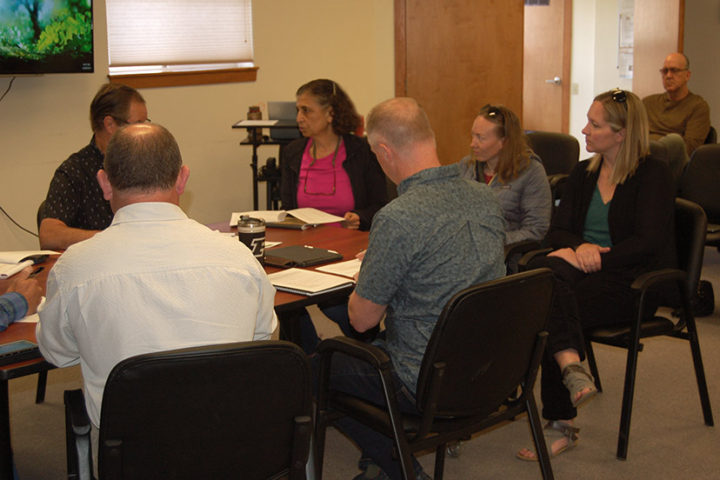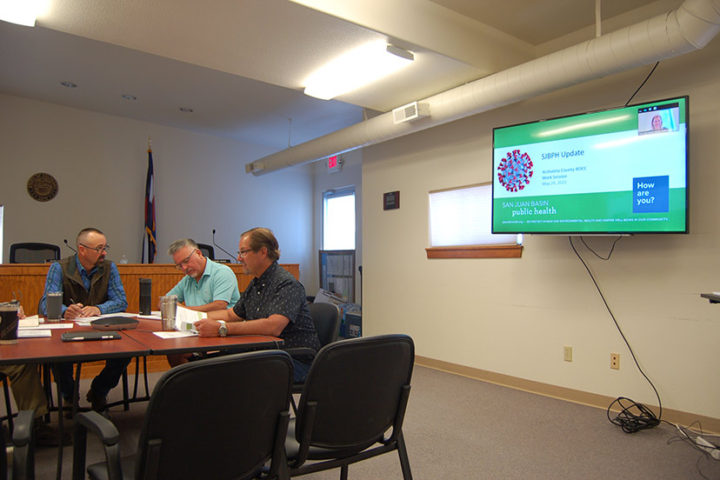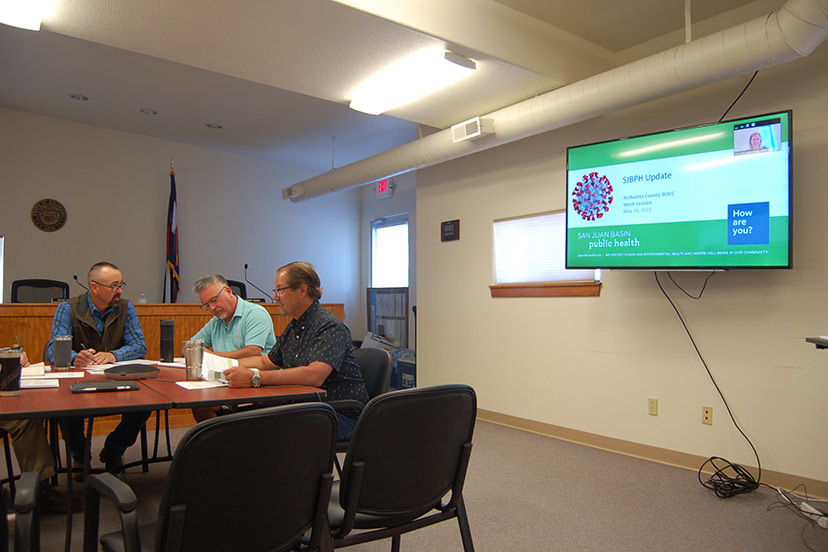San Juan Basin Public Health Executive Director Liane Jollon delivered a fairly lengthy report, via Zoom, to the Archuleta Board of County Commissioners on Tuesday, May 24, touching on the COVID-19 situation and also, answering some questions that the BOCC had posed to the Health District previously.
The work session had begun, however, with a different, and nearly as lengthy, presentation by three ladies — Mozhdeh Bruss, Vanessa Skean, and Ashley Wilson — on the topic of a proposed ‘Nutrition Security Health Equity Assessment’.
Here is Ms. Bruss:
“This is a project… the BOCC and Healthy Archuleta received funding from the Colorado Department of Public Health and Environment, Office of Health Equity, and the funding started in December. The need for this project was born out of two converging events. One was the 2019-2020 Community Food Assessment that was conducted by the Food Coalition, and also the interest of the Board of County Commissioners in studying the responsiveness and relevance of the health system structure in Archuleta County. So really, the purpose of that funding is to look at both of those.”

“This project will examine Nutrition Security and Health Equity in Archuleta County… A community health assessment will be undertaken to analyze efforts to address food insecurity, as well as explore new interventions to advance nutrition security. And then, the assessment will also look at areas of health equity…”
Ms. Bruss quoted some demographic statistics suggesting, among other things, that Archuleta County has a higher percentage of children who experience ‘food insecurity’ than does Colorado as a whole. The ladies had provided documentation to the commissioners and their staff, but not to those of us in the audience, so I was occasionally left wondering what some of the terms meant.
Food insecurity, for example. Is that the same as ‘hunger”… but more politically correct?
According to the Colorado Health Institute, food insecurity is defined as “eating less than [an individual or family] felt they should, in the past year, because there was not enough money for food.”
From that website:
Some Coloradans were more likely to experience food insecurity than others. A quarter of young adults in rural areas (25.4%) and a fifth of black Coloradans (22.2%) experienced food insecurity in 2019. People with lower incomes, Hispanic/Latinx Coloradans, and women were also disproportionately affected. By promoting equitable access to affordable, nutritious food, policymakers and community leaders have the power not only to fight hunger but to advance health equity in Colorado.
The website also reminds us of the obvious:
The connection between income and food insecurity is clear: The more a person earns, the easier it is to buy food.
There’s also a statistical relationship between poverty and access to adequate health care, and the ‘Nutrition Security Health Equity Assessment’ clearly aims to assign some numbers to that relationship, here in Archuleta County.
Ms. Skean spoke at some length on the subject of local and regional food, and how local families might be encouraged to grow their own food, and purchase locally grown food.
This idea — that we can encourage people to grow food in Archuleta County — strikes me, as an outside observer, as an inordinately ambitious goal. It seems to me that high-quality food grown by small-scale farmers and in family gardens is always going to be more expensive than assembly-line food production carried out by massive, highly mechanized commercial farms.
A family that cannot afford to put three meals a day on their table is unlikely to purchase more expensive, locally grown food, no matter how much ‘education’ they can be exposed to. Or so I would assume.
In terms of locally grown food, there are a few types of food production that align well with Pagosa’s high desert climate, and its relatively short and schizophrenic growing season. Cattle, for one. Sheep, for another. Chickens. But any rancher will tell you that keeping livestock healthy and well-fed is a challenging proposition.
Other types of food production can be even more challenging. Some years, an apple tree will bear fruit. Lettuce can often survive a late spring frost; squash and tomatoes often cannot. Sturdy fencing or a greenhouse is required to keep the deer out of the garden.
Meanwhile, the US Department of Agriculture tells us that, taking our whole farming and ranching industry into account, food production in Archuleta County has been a money-losing proposition. The most recent Archuleta County profile by USDA indicates that farming and ranching operations here lost a total of more than $2 million in 2017.
You can download that USDA summary here.
Should locally grown food be subsidized by federal, state and local governments, due to its higher nutritional value? I think there’s little argument that foods — especially fresh fruits and vegetables — lose nutritional value when they spend time in warehouses, traveling cross country in trucks, and sitting in grocery store refrigerators.
But does local food production ‘pencil’? Perhaps the ‘Nutrition Security Health Equity Assessment’ will help us answer some of the outstanding questions.
Over the past few days, the group known as Healthy Archuleta (dba FSFE – Food Coalition) has been conducting a community wide ‘participatory voting’ process, asking local citizens to choose their favorite ‘food security’ project for implementation in the coming months. The voting is now finished. I expect we will hear about the results, within the next week or so, and I hope we can share those results with our Daily Post readers.
Ms. Bruss addressed the commissioners at the conclusion of the 40-minute presentation:
“We appreciate your leadership and your support of this grant, and we hope you will continue — through your deliberations and through your discussions — continue hearing from us about this work, so that our community can continue moving towards healthier outcomes.”
Commissioner Warren Brown:
“It’s going to be a task, that’s for sure.”
The next presentation on Tuesday morning, delivered via Zoom by San Juan Basin Public Health Executive Director Liane Jollon, also concerned ‘health’.

Judging by the prominent drawing of a SARS-CoV-2 virus displayed on the large video screens in the meeting room, it was easy to surmise that we would be getting an earful about the COVID…

